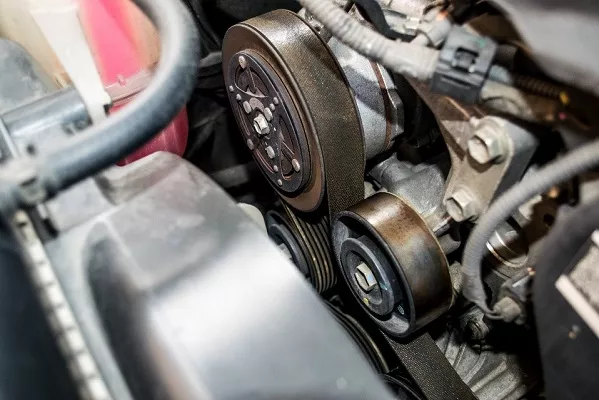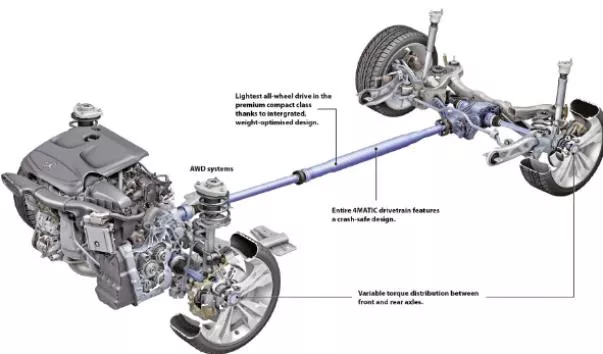Listed here are some of many methods on how to tell if a car is front-wheel drive, rear-wheel drive, full-time four-wheel drive or part-time four-wheel drive.
Drivetrain system is a system that helps transmit the power generated by the engine to the wheels and, as a result, move the car. For the most parts, a drivetrain system consists of the following components:
- Wheel axles
- Differential
- Driveshaft
- Auxiliary gearboxes
- Gearbox
On the front-wheel drive system, the gearbox is attached to a differential and it does not have a drive shaft with an auxiliary gearbox. In contrast, in the rear-wheel drive system, all components are separated with no auxiliary gearbox. Full-time four-wheel drive and part-time four-wheel drive systems include all of the components which are mentioned above, but some parts are not connected.
Method 1: Figure out the type of the vehicle
Figuring out the type of your car also lends a hand to help you guess what kind of driving system your car is having.
If you drive a family car, a mini car, a minivan or a luxury car, it is likely that the car will be equipped with a front-wheel drive system. One exception is for vehicles which were manufactured before the year 1990 in which most of the vehicles were equipped with rear-wheel drive. If your vehicle is a truck, a large utility vehicle, or a muscle car, it is likely that the vehicle is equipped with a rear-wheel drive system.
Note: Of course, there are exceptions, but as a general rule, these vehicles are equipped with the type of drivetrain systems which Philkotse.com has been mentioned above.

Is my car awd or fwd?
Method 2: Take a look at the direction of the engine
According to experienced consultants on car driving, by looking at the layout of the engine, you can determine whether your vehicle is a front or rear-wheel drive.
Step 1: Check the engine
Open the hood to check the engine.

Is my car 4 wheel drive?
Step 2: Identify the direction of the engine
The front of the engine does not necessarily aim at the front of the car. The front of the engine is where the drive belts are mounted.
Step 3: Figure out the location of the drive belts
If the belt is facing to the front of the car, it is likely that the driving system of the car is not the front-wheel drive. This engine layout is called a longitudinally mounted engine. As the gearbox is mounted on the rear end of the engine, it is unlikely that the vehicle power can be transmitted to the front wheels. If the drive belt faces to the side of the vehicle, the drive system is not the rear-wheel drive. This layout is named a transverse engine design.
Note: By only taking a look at the engine direction, you certainly could not identify the exact type of drive system of your car, but this action could prove to be helpful in narrowing down the possible type of the drive system.

Is my car all wheel drive?
Method 3: How to tell if your car is awd or fwd by checking the wheel axles
The axle shaft was designed for the function of transmitting the power generated by the engine to the wheel system. Which wheels are attached to the axle shaft is definitely the drive wheels.
Step 1: Check the bottom of the car
When you take a look at the bottom of a car, you could see the brakes, ball joints and wheel knuckle which locate near the rear wheels.
Step 2: Find the axle shaft made of metal
Look for a cylindrical metal shaft attached to the center of the wheel knuckle. The axle will be about 1 inch in diameter. At the end of the shaft, which attaches to the wheels, there will be a rubber cone guard. If you see the shaft, the vehicle is either a front or four-wheel drive.
Step 3: Check the rear differential
Experienced experts on car driving share that a differential is about the size of a small pumpkin and is mounted directly in between the two rear wheels. After identifying the differential, look for a long and solid tube that attaches to the differential or an axle shaft similar to the front axle shaft. If the rear differential is found, the rear axle is definitely in the drive system. In other words, the driving system is either a rear or four-wheel drive type.
In the case of vehicles come with both front and rear drive axles, the driving system is either a full-time or part-time four-wheel drive. If the engine is installed transversely and the car has both front and rear drive axles, it is as sure as eggs is eggs that the vehicle has a full-time four-wheel drive. If the engine is mounted in a longitudinal manner, the car is likely to be equipped with a part-time four-wheel drive system.

In the case of vehicles come with both front and rear drive axles, the driving system is either a full-time or part-time four-wheel drive
Method 4: Check VINs
The vehicle identification numbers (VIN) will help you confirm the type of driving system that the car is using. You can easily check the type of drivetrain by searching the VIN.
Step 1: Find a source to check VINs
There are many sites that offer VIN checkings, such as Carfax or CarProof, but you will be charged a fee. You can also search the VIN number on the free sites; however, the information will not be complete.

Find a source to check VINs
Step 2: Enter your VIN and see the results
if you use this way, it is likely that you have to pay.
Step 3: Find the results in the section about drivetrain set-up
- FWD stands for a front-wheel drive
- RWD stands for a rear-wheel drive
- AWD stands for a full-time four-wheel drive
- 4WD stands for a four-wheel drive
After using all of the above methods, if you still could not determine the type of driving system you are having, please contact a professional mechanic for help.
That is all you need to know regarding how to tell if a car is front wheel drive, rear-wheel drive, full-time four-wheel drive or part-time four-wheel drive. For more tips & tricks, check out Philkotse.com.
Recent posts
- Facts to know about 4WD cars before bringing one home Sep 20, 2021
- Top 5 best AWD cars for the money in the Philippines Sep 20, 2021
- 4WD vs AWD: Getting a grip on the road Sep 20, 2021











